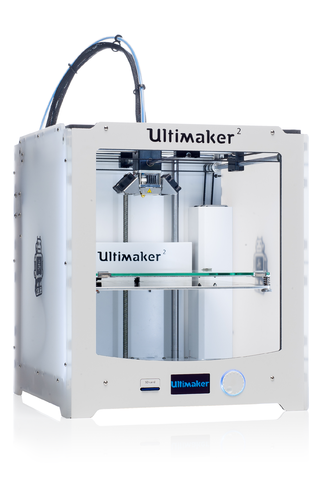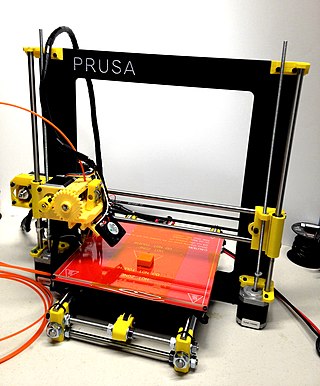Related Research Articles

Selective laser sintering (SLS) is an additive manufacturing (AM) technique that uses a laser as the power and heat source to sinter powdered material, aiming the laser automatically at points in space defined by a 3D model, binding the material together to create a solid structure. It is similar to selective laser melting; the two are instantiations of the same concept but differ in technical details. SLS is a relatively new technology that so far has mainly been used for rapid prototyping and for low-volume production of component parts. Production roles are expanding as the commercialization of AM technology improves.

Stereolithography is a form of 3D printing technology used for creating models, prototypes, patterns, and production parts in a layer by layer fashion using photochemical processes by which light causes chemical monomers and oligomers to cross-link together to form polymers. Those polymers then make up the body of a three-dimensional solid. Research in the area had been conducted during the 1970s, but the term was coined by Chuck Hull in 1984 when he applied for a patent on the process, which was granted in 1986. Stereolithography can be used to create prototypes for products in development, medical models, and computer hardware, as well as in many other applications. While stereolithography is fast and can produce almost any design, it can be expensive.

3D printing or additive manufacturing is the construction of a three-dimensional object from a CAD model or a digital 3D model. It can be done in a variety of processes in which material is deposited, joined or solidified under computer control, with the material being added together, typically layer by layer.

3D Systems, headquartered in Rock Hill, South Carolina, is a company that engineers, manufactures, and sells 3D printers, 3D printing materials, 3D scanners, and offers a 3D printing service. The company creates product concept models, precision and functional prototypes, master patterns for tooling, as well as production parts for direct digital manufacturing. It uses proprietary processes to fabricate physical objects using input from computer-aided design and manufacturing software, or 3D scanning and 3D sculpting devices.
Electron-beam additive manufacturing, or electron-beam melting (EBM) is a type of additive manufacturing, or 3D printing, for metal parts. The raw material is placed under a vacuum and fused together from heating by an electron beam. This technique is distinct from selective laser sintering as the raw material fuses having completely melted.

Rapid prototyping is a group of techniques used to quickly fabricate a scale model of a physical part or assembly using three-dimensional computer aided design (CAD) data. Construction of the part or assembly is usually done using 3D printing or "additive layer manufacturing" technology.
Behrokh Khoshnevis is the President and CEO of Contour Crafting Corporation and the Louise L. Dunn Distinguished Professor of Engineering at the University of Southern California (USC), where he has affiliations with the Aerospace & Mechanical Engineering, Astronautics Engineering, Civil & Environmental Engineering and Industrial & Systems Engineering departments. He is the Director of the Center for Rapid Automated Fabrication Technologies (CRAFT) at USC. He is a Member of the National Academy of Engineering, a Fellow Member of the National Academy of Inventors and is a Fellow of the American Society for the Advancement of Science. He is also a Fellow member of the Society for Computer Simulation International, a Fellow member of the Institute of Industrial & Systems Engineering and a Fellow member of the Society of Manufacturing Engineers. He is also a NASA Innovative Advanced Concepts (NIAC) Fellow.
Digital modeling and fabrication is a design and production process that combines 3D modeling or computing-aided design (CAD) with additive and subtractive manufacturing. Additive manufacturing is also known as 3D printing, while subtractive manufacturing may also be referred to as machining, and many other technologies can be exploited to physically produce the designed objects.

Selective laser melting (SLM) is one of many proprietary names for a metal additive manufacturing (AM) technology that uses a bed of powder with a source of heat to create metal parts. Also known as direct metal laser sintering (DMLS), the ASTM standard term is powder bed fusion (PBF). PBF is a rapid prototyping, 3D printing, or additive manufacturing technique designed to use a high power-density laser to melt and fuse metallic powders together.

Binder jet 3D printing, known variously as "Powder bed and inkjet" and "drop-on-powder" printing, is a rapid prototyping and additive manufacturing technology for making objects described by digital data such as a CAD file. Binder jetting is one of the seven categories of additive manufacturing processes according to ASTM and ISO.
Solid Concepts, Inc. is a custom manufacturing company engaged in engineering, manufacturing, production, and prototyping. The company is headquartered in Valencia, California, in the Los Angeles County area, with six other facilities located around the United States. Solid Concepts is an additive manufacturing service provider as well as a major manufacturer of business products, aerospace, unmanned systems, medical equipment and devices, foundry cast patterns, industrial equipment and design, and transportation parts.
Selective heat sintering (SHS) is a type of additive manufacturing process. It works by using a thermal printhead to apply heat to layers of powdered thermoplastic. When a layer is finished, the powder bed moves down, and an automated roller adds a new layer of material which is sintered to form the next cross-section of the model. SHS is best for manufacturing inexpensive prototypes for concept evaluation, fit/form and functional testing. SHS is a Plastics additive manufacturing technique similar to selective laser sintering (SLS), the main difference being that SHS employs a less intense thermal printhead instead of a laser, thereby making it a cheaper solution, and able to be scaled down to desktop sizes.

Formlabs is a 3D printing technology developer and manufacturer. The Somerville, Massachusetts-based company was founded in September 2011 by three MIT Media Lab students. The company develops and manufactures 3D printers and related software and consumables. It is most known for raising nearly $3 million in a Kickstarter campaign and creating the Form 1, Form 1+, Form 2, Form Cell, Form 3, Form 3L, and Fuse 1 stereolithography and selective laser sintering 3D printers.

Fused filament fabrication (FFF), also known as fused deposition modeling, or filament freeform fabrication, is a 3D printing process that uses a continuous filament of a thermoplastic material. Filament is fed from a large spool through a moving, heated printer extruder head, and is deposited on the growing work. The print head is moved under computer control to define the printed shape. Usually the head moves in two dimensions to deposit one horizontal plane, or layer, at a time; the work or the print head is then moved vertically by a small amount to begin a new layer. The speed of the extruder head may also be controlled to stop and start deposition and form an interrupted plane without stringing or dribbling between sections. "Fused filament fabrication" was coined by the members of the RepRap project to give an acronym (FFF) that would be legally unconstrained in its use.
3D metal moulding, also referred to as metal injection moulding or (MIM), is used to manufacture components with complex geometries. The process uses a mixture of metal powders and polymer binders – also known as "feedstock" – which are then injection-moulded.
Three-dimensional (3D) microfabrication refers to manufacturing techniques that involve the layering of materials to produce a three-dimensional structure at a microscopic scale. These structures are usually on the scale of micrometers and are popular in microelectronics and microelectromechanical systems.

William Masters is an American engineer, inventor, designer, manufacturing entrepreneur and business advisor/mentor. He holds the first 3D printing patent, along with patents for other 3D printing technologies and computer assisted manufacturing. He founded Perception Kayaks, at one time the largest kayak manufacturer in the U.S., and has served as a small business delegate to the Reagan and Clinton administrations.

Zero Point Frontiers Corporation (ZPFC) is a private aerospace firm based in Huntsville, Alabama. They, along with several other companies such as SpaceX, Blue Origin and Firefly Space Systems are proponents of NewSpace: a movement in the aerospace industry whose objective is to increase access to space through innovative technical advances resulting in a reduction of launch cost, and the lessening of regulations and logistical restrictions associated with dependence on national space institutions.

A variety of processes, equipment, and materials are used in the production of a three-dimensional object via additive manufacturing. 3D printing is also known as additive manufacturing, because the numerous available 3D printing process tend to be additive in nature, with a few key differences in the technologies and the materials used in this process.

Ian Gibson is a Professor of Design Engineering at the University of Twente. Gibson was selected as the scientific director of Fraunhofer Project Center at the University of Twente and is a recipient of lifetime achievement award, the Freeform and Additive Manufacturing Award. His main areas of research are in at the additive manufacturing, multi-material systems, micro-RP, Rapid Prototyping, Medical Modelling and tissue engineering.
References
- ↑ Lorincz, Jim. "Masters of Manufacturing: Carl R. Deckard PhD". Manufacturing Engineering Magazine. Retrieved 2 January 2014.
- ↑ Carl Robert Deckard, inventor of SLS, dies at 58
- 1 2 Lorenz, Jim. "Masters of Manufacturing: Carl R. Packard, PhD". Manufacturing Engineering Magazine. Retrieved 2 January 2014.
- 1 2 3 4 Lou, Alex. "Selective Laser Sintering, Birth of an Industry". University of Texas at Austin. Retrieved 2 January 2014.
- ↑ "3D Systems and DTM Corporation Announce Plans to Merge". NetComposites. Archived from the original on 2018-10-02. Retrieved 2018-10-01.
- ↑ "IT/Wireless". Austin Technology Incubator. Archived from the original on 12 January 2014. Retrieved 2 January 2014.
- ↑ "Patent US4938816-Selective laser sintering with assisted powder handling" . Retrieved 2 January 2014.
- ↑ "Patent US4863538" . Retrieved 2 January 2014.
- ↑ "Patent US4944817-Multiple material systems for selective beam sintering" . Retrieved 2 January 2014.